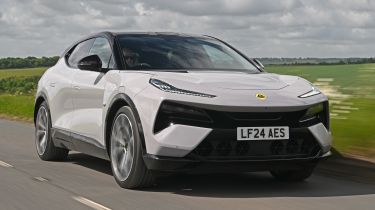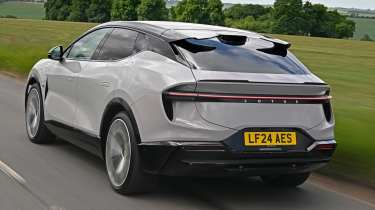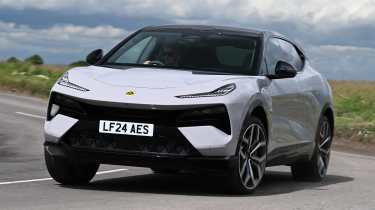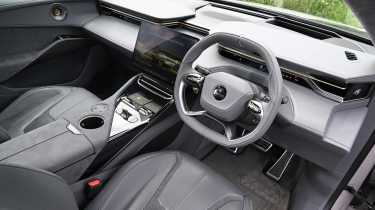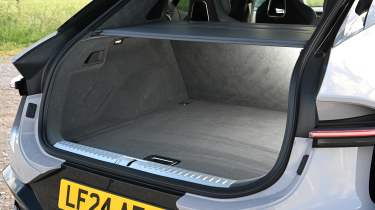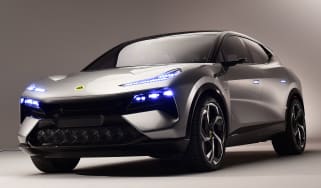Lotus Eletre review
The Lotus Eletre marks the beginning of a promising new era for the sports car maker, albeit a controversial one

Our opinion on the Lotus Eletre
It's not a Lotus in the traditional sense, but the Eletre is a new kind of car for the firm, for a new kind of world. And mostly it mostly works an absolute treat. It’s as entertaining to drive as it is high in quality, both inside and out. Dynamically, it’s as sharp as any conventional competitor from Lamborghini, Porsche, you name it – and at not dissimilar money. This is a great new car from Lotus, no mistake.
About the Lotus Eletre
The high-end SUV class has never been short of a performance-car brand or two. Porsche effectively kicked off the sector with the Cayenne, while Bentley, Rolls-Royce and even Ferrari and Lamborghini all offer buyers four or five-seat, high-riding, high-performance options – so for Lotus to dip its toe into this market isn’t a huge surprise.
Unlike many of those companies, Lotus has gone fully electric, too, and bearing in mind founder Colin Chapman’s famed “simplify and add lightness” mantra, a huge, heavy SUV created under the stewardship of Chinese owner Geely, does feel rather detached from what the British firm has built in the past.
Based on our encounters with the Eletre so far, it’s clear that there’s an awful lot to like here – even if for Lotus traditionalists it’ll be hard to trace any of the brand’s DNA beyond the oversized logo on the car’s nose.
Lotus Eletre prices and latest deals
Prices start from around £85,000 for the Lotus Eletre in base 600 spec, and this climbs by around £5,000 for the mid-range 600 GT and all the way to £95,000 for the GT SE. If you’d prefer the Sport variant, be prepared to fork out at least £105,000. Want more power? The 900 is priced from £130,000.
These prices certainly aren’t chicken feed, but the Auto Express Buy a Car service can save you a pretty penny when you spec your ideal Lotus Eletre. In fact, we offer average savings of around £3,800. We also have a number of new Lotus Eletres and used Lotus Eletres in stock and ready to go.
Performance & driving experience
Pros |
|
Cons |
|
Whether it’s building lightweight mid-engined two-seaters or large SUVs, Lotus remains a sports car brand, so buyers will expect performance from every model in the range. And it hasn’t held back with the Eletre. While it’s not without its flaws, this electric SUV’s ride and handling balance – with the focus on the latter – is among the best in the class.
| Model | Power | 0-62mph | Top speed |
| Lotus Eletre 600 | 603bhp | 4.5 seconds | 160mph |
| Lotus Eletre 900 | 905bhp | 2.95 seconds | 165mph |
Performance, 0-60mph acceleration and top speed
The range kicks off with the 600: its twin-motor set-up offers 603bhp and 710Nm of torque, which is good for a 0-62mph time of 4.5 seconds. In reality, few buyers will ever wish for any more; straight-line speed is excellent, and enough to see the Eletre pitch slightly onto its rear haunches as the driver demands full power.
Those with a more impatient disposition can demand more performance, though. At the top of the range, there’s the 900 powertrain, which ups the ante to the tuneof 905bhp and 985Nm of torque. Unlike the 600, the 900 uses a two-speed transmission to help maximise acceleration, and it allows the Eletre to cover the 0-62mph dash in a barely believable 2.95 seconds.
Town driving, visibility and parking
We drove the Eletre in close proximity to the brand’s Emeya saloon, and while there were some similarities, the Eletre didn’t quite offer the same level of composure and sophistication as its stablemate.
At low speed, this can be felt in its ride comfort; while the Emeya controls its mass well over big bumps, driving over the same road in the Eletre causes its body to sway from side to side a little more. There’s occasional crashiness to the suspension over larger potholes and drain covers, which takes the edge off the overall comfort compared with some rivals from BMW, Mercedes or Audi.
Country road driving and handling
At higher speeds, the ride starts to settle down, and while there’s always an underlying firmness, it feels well judged for a performance SUV. Engage sport mode, and the dampers tense slightly and the air suspension drops slightly closer to the road. Like this, the Eletre feels sharper to drive than the competition; in a class where most cars seem lethargic and wallowy, it is precise and sharp.
Its closest rival in the handling stakes, the BMW iX, can’t quite match the Lotus for front-end grip (unless you go for the sporty M70 variant), but it’s the steering that sets them apart more. The iX doesn’t have the feel and feedback of Hethel’s sports cars, although it’s well weighted and precise – the former in particular is very rare in this segment.
The Eletre’s brakes are powerful, but too sharp for our liking – especially because the throttle is a little soft in its initial response. It makes the controls feel a touch inconsistent.
Motorway driving and long-distance comfort
An already-hushed cabin is aided by noise-cancelling tech, which allows the speakers to drown out lower-frequency droning sounds, such as tyre roar. As a result, high-speed refinement in the Eletre is superb – and up there with the class-leading BMW iX.
There’s still huge performance on offer, too, which makes the Eletre feel fairly effortless to drive. Much like in Sport mode, Range drops the ride height slightly to reduce high-speed drag. The ride height can also be controlled independently of the drive modes via the touchscreen.
“I found the Eletre to be slightly sharper to drive than the BMW iX, especially when pushed hard, but the Bavarian runs it close while returning superior ride comfort and refinement.” - Alex Ingram, chief reviewer.
Range, charging & running costs
Pros |
|
Cons |
|
There’s no denying that the Lotus Eletre is very much a premium car with an equally premium price. However, many of the usual EV savings still apply here, and healthy residual values will help to prevent any major heartbreak when it’s time to sell.
Electric range, battery life and charge time
At 112kWh (109kWh of which is usable), the Eletre has one of the larger battery capacities in its class, but it doesn’t make particularly efficient use of it. Officially, the Eletre 600 is claimed to cover between 329 and 373 miles on a charge, depending on specification and wheel size.
However, we struggled to get close to those numbers in the real world. A range of around 260 miles looked like the norm, thanks to a return of 2.4 miles/kWh. That was in warm conditions, too – in winter, we’d expect that number to drop further. While few people will ever cover much more than 200 miles in one stint, we’d like to see more wiggle room on the range – especially in a car at this price point. There is one saving grace, though, and that’s the Eletre’s charging speeds.
The biggest challenge will be to find public chargers fast enough to keep up, but plug into a network that can handle the 350kW capability, and a 10-80 per cent top-up can take as little as 20 minutes. While we didn’t see that number when plugged in, we did note that even with charge levels well over 80 per cent – the point at which many EVs’ charge speeds drop off significantly – the Eletre was still capable of taking almost 150kW.
Of course, it’s possible to charge overnight at home via the supplied Type 2 cable. One very minor gripe we had here is that thick cables like these naturally want to curl into a circle, but the cable bag that Lotus supplies is a rectangle, which makes it awkward to pack.
| Model | Battery size | Range | Insurance group |
| Lotus Eletre 600 | 112kWh (109kWh useable) | 373 miles | 50 |
| Lotus Eletre 900 | 112kWh (109kWh useable) | 310 miles | 50 |
Insurance groups
Unsurprisingly for a 600bhp-plus SUV, all versions of the Lotus Eletre are ranked in the group 50 category for insurance.
Tax
The fully electric powertrain will make the Eletre an attractive company-car proposition to those on a suitably high pay grade. Despite the near six-figure price tag, higher-rate income tax payers will face annual deductions of just over £1,000. This will climb to £1,400 in the 2026/27 financial year, though, as Benefit-in-Kind rates for EVs gradually increase by one per cent per year.
Depreciation
Holding onto roughly 49 per cent of its original value after three years or 36,000 miles, the Eletre 600’s residuals are competitive compared with its German rivals. The more potent 900 version loses more money, though; it’s predicted to lose almost 60 per cent of its value over the same period.
Interior, design & technology
Pros |
|
Cons |
|
It’s fair to say that luxury hasn’t ever been a strong point for Lotus, or something that the brand has given much consideration at all – understandable, given the lightweight focus. But shoddy finishes don’t fly in a six-figure SUV, and the good news is that the Eletre’s cabin feels like a truly special place to sit.
Interior and dashboard design
The Eletre’s materials, controls and overall design manage to look unlike any of its rivals’, yet feel expensive and well finished, too.
The steering wheel is fantastic to hold, and while some testers thought the switchgear looked a little chintzy, it all worked well. This includes the steering wheel-mounted paddles, with each side effectively split in two; those on the left toggle through four stages of motor regeneration, while the other side scrolls through the drive modes. Temperature can be controlled via the touchscreen display, while a physical toggle below can be programmed to either control the temperature or the fan speed; we set it to the latter, because we found the on-screen temperature controls to be fairly easy to use anyway.
Materials and build quality
Hide the badges, and many people would be hard pressed to tell that they’re in a Lotus. But we mean that in the best possible way, because the quality and luxury are truly first rate.
Infotainment, sat-nav and stereo
Some of the more eye-catching pieces of tech come in the four-seat package. The individual seats are both electrically adjustable and come with various massage functions. Much of this can be adjusted through a centre screen, which also includes controls for the media, audio system and sunroof. The display itself angles upwards towards the users to make it easier to operate.
“The Eletre is available with a sound system by British audio firm KEF. Not only do the exposed speaker cones look beautifully intricate, but the 1,380-watt 15-speaker set-up has plenty of punch, too.” - Alex Ingram, chief reviewer.
Boot space & practicality
Pros |
|
Cons |
|
Rear-seat passengers have clearly been a focus for Lotus designers, because the Eletre is a truly luxurious place in which to be chauffeured around.
Dimensions and size
Spot an Eletre on the road and its sheer presence will certainly catch your eye. It’s pretty much the polar opposite of Lotus’s low-slung, lightweight sports cars, but this added bulk really pays off when it comes to interior space.
Dimensions comparison | |||
| Model | Lotus Eletre | BMW iX | Polestar 3 |
| Length | 5,103mm | 4,965mm | 4,900mm |
| Width | 2,019mm | 1,970mm | 1,968mm |
| Height | 1,636mm | 1,695mm | 1,622mm |
| Wheelbase | 3,019mm | 3,000mm | 2,985mm |
| Boot space | 688 to 1,532 litres (to roof) | 500 to 1,750 litres | 484 to 1,411 litres |
Seats & passenger space
Up front, the Eletre offers a clear view of the road ahead, despite a relatively sporty driving position by SUV standards. One minor flaw that we found with the model’s frameless doors is that, on a rainy day, water would tend to run off the roof and straight onto the seat and door trim – not very luxurious on a car with a six-figure price tag.
Little else in this – or any other – segment can match the Eletre for rear knee room. The space is simply huge, lending the back seats a truly limo-like feeling. Headroom is also very good, although the BMW iX is better still. The sloping roofline combined with a gently rising windowline make the cabin seem a little more cocooned from the outside world than the more open feel of the BMW.
Boot space
At 688 litres, the boot capacity of the Eletre looks superb on paper. Yet that number flatters things somewhat, because the quoted measurement is to the roof (rather than to the window line, which is how most of its rivals are measured) and the roof itself slopes downwards, so some alternatives are better for holding very bulky items. It is still a generous space, though.
Unlike some rivals, including the BMW iX, the Eletre benefits from a ‘frunk’ – a useful feature for keeping the charging cables separate from the rest of the luggage. The 46-litre space is enclosed by a second cover beneath the bonnet itself.
Towing
The Eletre 900 is rated to tow up to 2,250kg braked. However, if you do wish to hook up a trailer or caravan, the electric towbar is a £1,100 option.
“The Eletre is very marginally tighter than the BMW, but nothing else in the segment comes close for knee room – it’s simply vast. An optional four-seat package makes the Lotus’s rear quarters feel even more opulent, with superbly comfortable massaging seats.” - Alex Ingram, chief reviewer.
Reliability & safety
Pros |
|
Cons |
|
Euro NCAP hasn’t assessed the Eletre yet, but it’s a car that’s packed with advanced driver-assistance tech. All models feature blind- spot warning, lane-keep assistance, adaptive cruise control and a driver-monitoring system. While so many cars with Chinese origins tend to offer clumsy versions of these systems, the Eletre’s tech is fairly subdued and rarely felt intrusive.
Unfortunately, we’re yet to see Lotus appear in our Driver Power survey, either in the best car to own or best car manufacturer rankings. However, EVs carry fewer moving parts than combustion-powered vehicles, so this should work in favour of its reliability.
Buying and owning
- Best buy: Lotus Eletre 600
With the sheer amount of space, sportiness and quality that the Eletre offers even in entry-level spec, we’re not really sure there’s that much need to fork out any extra cash (unless you really want the extra kit or towing capacity).
Lotus Eletre alternatives
Those in the market for an electric SUV that’s genuinely good to drive have a small but talented bunch to choose from. The BMW iX is the closest rival in terms of interior space, plushness and driving ability, but if size isn’t too important, the Porsche Macan Electric is smaller in stature but just as mighty from behind the wheel.
Frequently Asked Questions
Lotus offers a generous five-year, 100,000-mile warranty with the Eletre, beating the packages on rivals from BMW and Audi.

